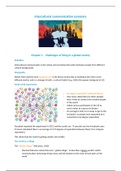Samenvatting
Summary Introducing Intercultural Communication: Global Cultures and Contexts (Chapter 1-10+13, Article 3+4)
- Instelling
- Radboud Universiteit Nijmegen (RU)
A summary of Introducing Intercultural Communication: Global Cultures and Contexts (2nd Edition). Besides it includes lecture notes and notes for article 3 and 4 (Week6). At the end there is also a brief overview of the chapters. Many pictures of models with explanations for better understanding. G...
[Meer zien]








